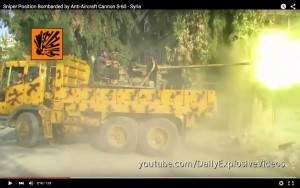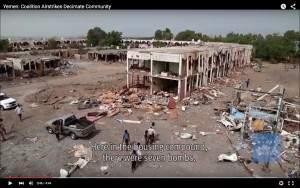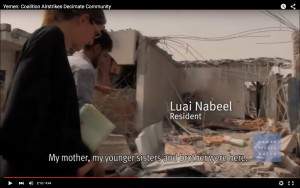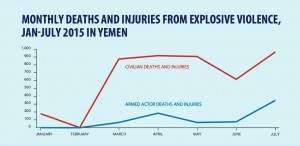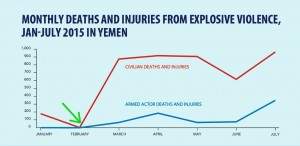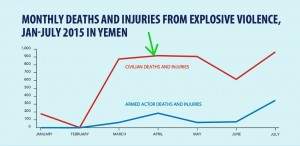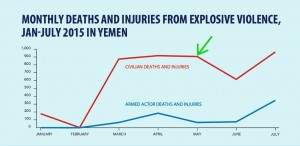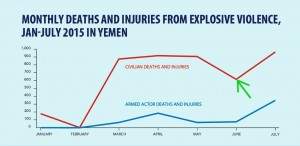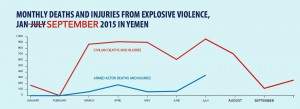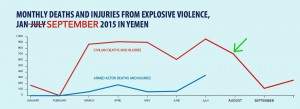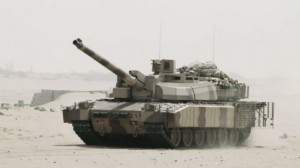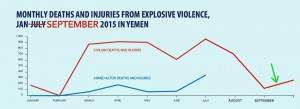The war is saving Yemeni lives
September 28, 2023 by Thomas Wictor
Yesterday I wrote a post titled “In Yemen No Evidence is Required.” It’s about how the press and NGOs slander the Saudi-led Coalition fighting Ansar Allah, the Iranian-backed Shi’ite terrorist group also called the Houthis. One such dishonest NGO is Action on Armed Violence (AOAV), which issued the entirely fraudulent report State of Crisis: Explosive Weapons in Yemen. It’s obvious that AOAV doesn’t care about Yemeni lives, as I’ll show you in a moment.
First, a good example of the utterly fact-free reporting about Yemen. There was one thing missing from the accusations hurled at the Coalition. It comes up every time an armed force goes to war against terrorists. Today the Houthis rectified their oversight.
Saudi-led airstrikes hit Yemen wedding party, killing at least 28
Senior government official says strikes, which also wounded dozens of people, were ‘a mistake’
Yemeni security officials said two airstrikes by the Saudi-led coalition targeting the country’s Shia rebels hit a wedding party, killing 28 people and wounding dozens.
The officials, who remain neutral in the conflict that has splintered Yemen, said Monday’s strikes hit the celebration in al-Wahga, a village near the strait of Bab al-Mandab.
There always have to be bombed wedding parties. The ritualized reporting isn’t complete without them. And maybe some Yemenis reading this can tell me which of your “security officials” are neutral in the conflict, meaning they support neither the Houthis and Saleh or President Hadi and the Coalition. Are they the Swiss of Yemen?
A figure of 28 dead wedding-party guests wasn’t horrific enough, so the Houthis came back with a different death toll.
Airstrikes hit wedding in Yemen; as many as 135 dead
Airstrikes devastated a wedding party in southern Yemen on Monday, killing and injuring dozens, witnesses said. Medics put the death toll as high as 135, including many women and children, in the latest bombardment reported to have caused large numbers of civilian deaths and injuries.
The Saudi-led air offensive in Yemen, now in its seventh month, has killed at least 3,500 people, perhaps half of them civilians, according to aid groups.
Although a gruesome video purports to show the aftermath of the event, it doesn’t match “eyewitness accounts” that two bombs struck tents.
These aren’t tents.
The shallow crater (red arrow) and the blast damage are consistent with a large improvised explosive device (IED).
That’s not a crater from an aerial munition, because it’s in open ground. The Coalition wouldn’t use a precision-guided aerial munition to hit the only empty space in the area. It was almost certainly a car bomb, as the location of the crater (red arrows) indicates.
Once upon a time, journalists led with the reality of the story. Now the narrative comes before reality.
The death toll from a suspected air strike on a wedding party in Yemen on Monday has risen to at least 130, the United Nations and local medics say.
Missiles reportedly hit two tents in a village near the Red Sea port of Mocha, where a man linked to the Houthi rebel movement was celebrating his marriage.
But the Saudi-led coalition that has been bombing the rebels for six months denied responsibility for the attack…
[A] coalition spokesman vehemently denied it was behind the attack. A spokesman said: “There have been no air operations by the coalition in that area for three days. This is totally false news.”
Of course it’s totally false news. You can see with your own eyes that tents were not struck. The accusation of an air strike is a lie. It’s clear that the Houthis set off an IED in order to blame the deaths on the Coalition. Images of the dead show that the victims disintegrated, yet they had no injuries from fragmentation. They were killed by blast, the hallmark of an IED.
Similarly, the Human Rights Watch video below is utterly bogus. There’s no sign that aerial munitions were used.
The beginning of the video shows muzzle blasts from anti-aircraft artillery (AAA) pieces parked in residential areas. Those aren’t bombs exploding.
If they had been aerial munitions, the cameraman would’ve been blown into tiny pieces. The gun is the 57mm S-60. This is the muzzle blast in the brightness of the Syrian sun.
At night it’s even more intense.
As for the damage in Mocha, there are no craters in the ground, no holes in the roofs, and no evidence of fragments from high-explosive aerial munitions.
Everything you see in the photo above is blast damage, caused by pressure waves. The Houthis placed IEDs in rooms and detonated them. Bombs that cause blast damage but don’t leave evidence of razor-sharp fragments are usually made from ammonium nitrate and fuel oil (AMFO).
The entire reinforced-concrete roof is gone, but there’s no crater in the floor of the building.
That’s definitive proof that an IED and not an aerial munition was used. Expert bomb makers can channel the force of the blast. It’s clear that the explosion released energy upward and out the front of the building but not toward the rear. Neither the Coalition nor the IDF could drop an aerial munition that would produce this signature.
It was an IED. Human Rights Watch is lying.
Now, on to the AOAV report State of Crisis. It has a very interesting graph.
Note that it stops in July. I’ll explain why in a moment.
First, let’s look at dates. February 5, 2015, was the day that the Houthis dissolved the Yemeni parliament. As you can see by the green arrow, that was when civilian casualties began increasing at a horrendous rate, from zero to almost 900 a day in less than a month.
This figure of almost 900 casualties a day remained constant for a month. Then on March 26, 2015, the Saudi-led Coalition began an aerial campaign to degrade Houthi military capabilities and protect two pockets of resistance: Little Aden and Crater.
The green arrow in the graph above shows when Operation Decisive Storm started. Note that the civilian casualty rate remained unchanged for over a month, despite the heavy air strikes. Only one of two possibilities can explain that: Either the Coalition steadily killed and injured the exact number of people being spared by newly merciful Houthis, thus making the butcher’s bill remain constant; or else the Coalition has killed and injured virtually no civilians.
Given the weapons used by the Coalition, the photos and videos I’ve seen, the lack of evidence of mass civilian casualties, and the savage nature of the Houthis, I can say with total certainty that the Coalition has killed and injured virtually no Yemeni civilians. The exceptions are dissenters who the Houthis kidnap and put in military targets so that they’ll die.
On May 2, 2015, the Coalition landed about 35 Yemeni special forces and 15 United Arab Emirates Presidential Guardsmen in Crater. While the Yemenis organized the resistance, from May 4 the Emiratis engaged in combat with the Houthis, Saleh loyalists, and militia of the Revolutionary Committee. The Guardsmen were armed with Javelin antitank guided missiles (ATGMs), which they used to destroy armored vehicles, combat posts, and groups of khat-chewing fighters.
If we look at the casualty chart, we see that beginning in May, civilian deaths and injuries dropped significantly (green arrow).
By killing Houthis, the Emirati Presidential Guardsmen prevented civilian casualties. The evidence is incontrovertible.
On June 8 and June 24, the Houthis launched major assaults on Little Aden and Crater. We see that beginning in June (green arrow), civilian casualties began going up again, since the Houthis use artillery and rocket fire without regard to whom they’re shelling.
I wondered why the reporting stopped at the end of June. What would the graph look like if I used the AOAV “methodology” applied to State of Crisis? I therefore spent the day reading English-language media reports. Whenever the figures of dead and injured conflicted, I always chose the higher number.
Here’s the AOAV graph extended out to today, September 28, 2015. The reports I read mentioned only civilians.
Beginning in July, civilian deaths and injuries began declining. What did the Coalition do in July?
On July 14, seventy-five MRAPs with around 600 [Yemeni] troops broke out of the western perimeter of Little Aden and captured a new berth, Ras Amran, then hooked northeast to capture the road systems north of Aden city. Another 95 MRAPs and 300 troops were ferried across Aden harbor to the Crater pocket to liberate Aden International Airport and the city. UAE and Saudi special forces and eight UAE Enigma fighting vehicles with quad-mounted remote-control missile systems accompanied attacking forces. By the end of the day, Southern Resistance forces recaptured the airport with support from a flying column of MRAPs operated by trained Yemenis and a small number of UAE special forces.
This is a photo of the above action taking place. These are mine resistant ambush protected vehicles (MRAPs).
Beginning in August, Yemeni civilian casualties declined even more (green arrow).
What happened in August?
On August 3, hundreds of UAE armored vehicles broke out of Aden and headed toward Marib.
On August 4, a force of Yemeni tanks and mechanized infantry—accompanied by Saudi special operators—entered Yemen at the al-Wadiya border post. These troops also headed toward Marib.
On September 7, Qatar sent 1000 special forces, 200 tanks, and 30 Apache gunships to Marib.
On September 12, a ground battle at Marib began. Civilian casualties are edging up again (green arrow).
Yemenis tell me that in reality, the Houthis are murdering people in places such as Taiz and blaming the Coalition. These civilians aren’t being caught in the crossfire.
By the beginning of March, 2015, almost 900 Yemeni civilians were being killed or injured per month. Currently Yemen is being bombed by the Coalition, and a major ground war is taking place. The total reported civilian casualties for September of 2015 is 271. I found a violently anti-Saudi Website that lists daily Coalition activity. These figures come from someone who blames the Coalition for all harm done to Yemenis.
July 23, 2023 - More than 100 air strikes nationwide. Eleven people reported killed or injured.
July 24, 2023 - More than 100 air strikes in Aden alone. Four people reported killed or injured.
August 2, 2023 - More than forty air strikes reported. No Yemeni casualties.
August 4, 2023 - More than forty air strikes reported. No Yemeni casualties.
The war is saving Yemeni lives. There’s absolutely no doubt that the Houthis are responsible for the overwhelming majority of civilian deaths.
This article viewed 848 times.



